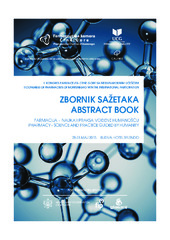Приказ основних података о документу
Primena različitih in vitro tehnika za predviđanje permeabilnosti kroz krvno-moždanu barijeru liganada imidazolinskih receptora
Application of different in vitro techniques for predicting blood brain barrier penetration imidazoline receptor ligands
| dc.creator | Vučićević, Jelica | |
| dc.creator | Popović, Marija | |
| dc.creator | Nikolić, Katarina | |
| dc.creator | Filipić, Slavica | |
| dc.creator | Gagić, Žarko | |
| dc.creator | Agbaba, Danica | |
| dc.date.accessioned | 2023-09-15T10:15:43Z | |
| dc.date.available | 2023-09-15T10:15:43Z | |
| dc.date.issued | 2015 | |
| dc.identifier.uri | https://farfar.pharmacy.bg.ac.rs/handle/123456789/5029 | |
| dc.description.abstract | Ligandi imidazolinskih receptora predstavljaju brojnu familiju biološki aktivnih jedinjenja koja imaju široku terapijsku primenu. Ovi ligandi mogu delovati na tri tipa imidazolinskih receptora (I1- IR, I2-IR and I3-IR) I na alfa2-adreno receptore. Imidazolinski receptori suodgovorni za različite biološke aktivnosti imidazolina. Stoga neki IRs ligandi su danas značajni za ispitivanje kao novi centralno delujući antihipertenzivi i potencijalni kandidati za lečenje različitih neuroloških oboljenja. Cilj ovog rada je bio da se proceni permeabilnost ovih liganada kroz Krvno-Moždanu Barijeru (KMB). Test permeabilnosti na veštačkim paralelnim membranama (eng. Parallel Artificial Membrane Permeability Assay, PAMPA), bioparticiona micelarna hromatografija (eng. Biopartitioning Micellar Chromatography, BMC) i reverzno-fazna tečna hromatografija pod visokim pritiskom (eng. Reversed-Phase High-Performance Liquid Chromatography, RP-HPLC) su in vitro tehnike korišćenje za predviđnje permeabilnosti kroz KMB imidazolinsih liganada. Vrednosti dobijene korišćenjem PAMPA i BMC su ispitivane metodologijom kvantitativnog odnosa struktura i osobina jedinjenja (eng. Quantitative Structure-Property Relationship, QSPR). Retencioni faktori dobijeni korišćenjem BMC I RP-HPLC su korelisani sa koeficijentima permeabilnosti dobijeni korišćenjem PAMPA. Pored toga, PLS (eng. Partial Least Square), MLR (eng. Multiple Linear Regression) i ANN (eng. Artificial Neural Networks) modeli su razvijeni korišćenjem retencionih podataka iz BMC sistema/efektivnih permeabilnosti iz PAMPA I molekulskih parametara izračunatih za optimizovane strukture. Dominantni molekulski/katjonski oblici jedinjenja na pH=7.4 su dobijeni korišćenjem MarvinSketch. Geometrijska optimizacija liganada je izvršena korišćenjem Chem3DBio Ultra. Molekulski deskriptori za optimizovana jedinjenja su izračunati korišćenjem Chem3DBio Ultra, Dragon and ADMET predictor programa. U ovoj QSPR studiji retencioni faktori/efektivne permeabilnosti jedinjenja su korišćene kao zavisne, dok izračunati deskriptori su korišćeni kao nezavisne varijable. SIMCA je korišćena za PLS analizu dok je postupno MLR i ANN modeliranje izvršeno korišćenjem STASTICA Neural Networks programa. Prognostički potencijal formiranih QSPR modela je potvrđen ukrštenom i eksternom validacijom. Formirani QSPR modeli mogu biti korišćeni kao brzi skrining metod za procenu krvno-moždane permeabilnosti novih liganada imidazolinskih receptora, koji predstavljaju potencijalne kandidate u lečenju hipertenizije i neuroloških oboljenja. | sr |
| dc.description.abstract | Imidazoline receptor ligands are a numerous family of biologically active compounds with many therapeutic applications. Those ligands can act at the three types of imidazoline receptors (I1-IR, I2- IR and I3-IR) and alpha2-adrenoceptors. Imidazoline receptors (IRs) are responsible for the versatile biological activities of imidazolines. Therefore some IRs ligands are examined as novel centrally 192 acting antihypertensives and drug candidates for treatment of various neurological diseases. The aim of this work was to evaluate Blood-Brain Barrier (BBB) permeability of these ligand. ParallelArtificial Membrane Permeability Assay (PAMPA) Biopartitioning Micellar Chromatography (BMC) and Reversed-Phase High-Performance Liquid Chromatography (RP HPLC) are in vitro techniques used for predicting BBB penetration of imidazoline ligands. The values obtained using PAMPA and BMC were studied by the Quantitative Structure-Property Relationship (QSPR) methodology. 5HWHQLRQ IDFWRUV REWDLQHG XVLQJ %0& DQG 53 +3/& ZHUH FRUUHODWHG ZLWK SHUPHDELOLW\ FRHI¿FLHQWV obtained using PAMPA. Further, Partial Least Square (PLS), Multiple Linear Regression (MLR) DQG $UWL¿FLDO 1HXUDO 1HWZRUNV $11 PRGHOV ZHUH GHYHORSHG XVLQJ UHWHQWLRQ GDWD IURP %0& system/effective permeabilities from PAMPA and molecular parameters calculated for the optimized FRPSRXQGV 7KH GRPLQDQW PROHFXOHV FDWLRQ VSHFLHV RI FRPSRXQGV DW S+ KDYH EHHQ REWDLQHG using the MarvinSketch. Chem3DBio Ultra program was applied for geometry optimization. The molecular descriptors were calculated for the optimized compounds using ChemBio3D Ultra, Dragon and ADMET predictor software. Retention factors/effective permeabilities of compounds were used as dependant variable, while calculated molecular parametres were used as independent variables in the QSPR study. SIMCA was used for PLS analysis, while the stepwise MLR and ANN modeling were performed using STASTICA Neural Networks. Predictive potential of the formed models was FRQ¿UPHG E\ /HDYH 2QH 2XW &URVV DQG H[WHUQDO YDOLGDWLRQ Formed QSPR models can be used as a fast screening method for assessment of brain penetration of novel imidazoline receptor ligands, as promissing drug candidates for treatment of hypertension or neurological diseases. | |
| dc.language.iso | sr | sr |
| dc.language.iso | en | sr |
| dc.publisher | Univerzitet Crne Gore Farmaceutski fakultet | sr |
| dc.publisher | Farmaceutska komora Crne Gore | sr |
| dc.relation | info:eu-repo/grantAgreement/MESTD/Basic Research (BR or ON)/172033/RS// | sr |
| dc.rights | openAccess | sr |
| dc.source | II Congress of pharmacists of Montenegro with the international participation, 28-31.may 2015. Budva, Montenegro, Abstract book | sr |
| dc.subject | Imidazolines | sr |
| dc.subject | PAMPA | sr |
| dc.subject | BMC | sr |
| dc.subject | RP-HPLC | sr |
| dc.subject | QSPR | sr |
| dc.subject | Imidazolini | sr |
| dc.title | Primena različitih in vitro tehnika za predviđanje permeabilnosti kroz krvno-moždanu barijeru liganada imidazolinskih receptora | sr |
| dc.title | Application of different in vitro techniques for predicting blood brain barrier penetration imidazoline receptor ligands | |
| dc.type | conferenceObject | sr |
| dc.rights.license | ARR | sr |
| dc.citation.spage | 190 | |
| dc.citation.epage | 192 | |
| dc.description.other | Abstract book - Pharmacy - science and practice guided by humanity | sr |
| dc.identifier.fulltext | http://farfar.pharmacy.bg.ac.rs/bitstream/id/13848/Application_of_different_pub_2015.pdf | |
| dc.identifier.rcub | https://hdl.handle.net/21.15107/rcub_farfar_5029 | |
| dc.type.version | publishedVersion | sr |

